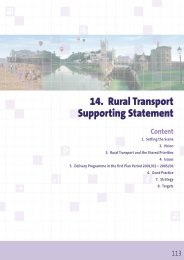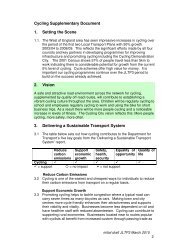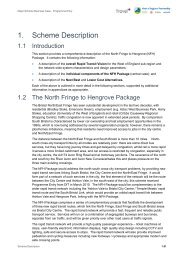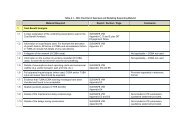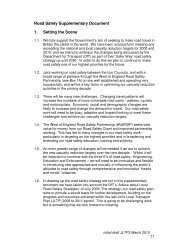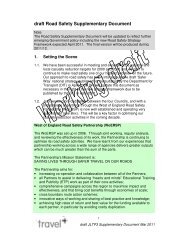2. Vision, Goals and Challenges
2. Vision, Goals and Challenges
2. Vision, Goals and Challenges
You also want an ePaper? Increase the reach of your titles
YUMPU automatically turns print PDFs into web optimized ePapers that Google loves.
<strong>2.</strong> <strong>Vision</strong>, <strong>Goals</strong> <strong>and</strong> <strong>Challenges</strong><br />
<strong>2.</strong>1 Introduction<br />
<strong>2.</strong>1.1 We need a vision to drive the Joint Local Transport Plan 3 (JLTP3), a<br />
picture of how our transport network might look in 2026.<br />
<strong>2.</strong>1.2 This coincides with the timescale for the draft Regional Spatial<br />
Strategy. The homes <strong>and</strong> jobs the Strategy expects us to deliver is our<br />
biggest challenge. Hence it makes sense to tie the two up.<br />
<strong>2.</strong>1.3 To guide the JLTP3 there is the shared West of Engl<strong>and</strong> vision (see<br />
Box 2a), the vision from the Joint Local Transport Plan 2006 to 2011<br />
(see Box 2b) <strong>and</strong> our Sustainable Community Strategies <strong>and</strong><br />
Corporate Plans. These visions remain highly relevant <strong>and</strong> it is not the<br />
intention of the JLTP3 to revisit them. We need to have aspirations but<br />
be realistic at the same time.<br />
Box 2a: Summary of West of Engl<strong>and</strong> vision<br />
• A buoyant economy.<br />
• A rising quality of life for all.<br />
• Easier local, national <strong>and</strong> international travel.<br />
• Cultural attractions that make the West of Engl<strong>and</strong> a place of choice.<br />
• Approach to delivery that is energy efficient, protects air quality,<br />
minimises waste <strong>and</strong> protects <strong>and</strong> enhances the natural <strong>and</strong> the<br />
built environment.<br />
• Makes positive use of the mix of urban <strong>and</strong> rural areas.<br />
Box 2b: JLTP <strong>Vision</strong> 2006 to 2011<br />
The <strong>Vision</strong> is a transport system that:<br />
• Strengthens the local economy;<br />
• Supports rising quality of life <strong>and</strong> social inclusion;<br />
• Improves access <strong>and</strong> links;<br />
• Ensures that alternatives to the car are a realistic first choice for the<br />
majority of trips;<br />
• Offers real choice - affordable, safe, secure, reliable, simple to use<br />
<strong>and</strong> available to all; <strong>and</strong><br />
• Meets both rural <strong>and</strong> urban needs.<br />
<strong>2.</strong>1.4 The vision is just the starting point. We will deliver it through a Joint<br />
Local Transport Plan based around the five key goals from the<br />
Department for Transport’s “Delivering a Sustainable Transport<br />
System” (DaSTS) of:<br />
8<br />
Initial draft JLTP3 March 2010
• Reduce carbon emissions<br />
• Support economic growth<br />
• Promote equality of opportunity<br />
• Contribute to better safety, security <strong>and</strong> health<br />
• Improve quality of life <strong>and</strong> a healthy natural environment<br />
<strong>2.</strong>1.5 We believe these five goals provide a robust basis for the JLTP3,<br />
support the visions <strong>and</strong> help us focus on delivery. As Box 2c<br />
demonstrates we have taken each goal <strong>and</strong> shaped a series of<br />
challenges <strong>and</strong> issues of local importance around them backed up by<br />
robust evidence.<br />
<strong>2.</strong>1.6 Looking forward to 2026 this vision needs to be seen in the context of a<br />
fast moving world with changing technology, lifestyles, national policies<br />
<strong>and</strong> Governments <strong>and</strong> the potential challenges of climate change <strong>and</strong><br />
peak oil. We need to be practical <strong>and</strong> realistic but we still need one<br />
eye on the future.<br />
<strong>2.</strong>1.7 Indeed the city regions that will prosper in the 21st century will be those<br />
that successfully adapt their approach to travel <strong>and</strong> transport. Within<br />
densely populated areas the normal choice will be safe, reliable,<br />
comfortable <strong>and</strong> affordable public transport combined with walking <strong>and</strong><br />
cycling. This must be carefully planned to link with the transport<br />
networks in the surrounding rural areas, where the car will continue to<br />
play a major part alongside improved public transport, walking <strong>and</strong><br />
cycling.<br />
9<br />
Initial draft JLTP3 March 2010
Box 2c JLTP3 <strong>Goals</strong>, <strong>Challenges</strong> <strong>and</strong> Evidence<br />
Strategic Goal Our challenge Evidence Local importance<br />
Goal 1: Reduce<br />
carbon emissions<br />
• Reduce greenhouse gas<br />
emissions.<br />
• Resilient <strong>and</strong> adaptable transport<br />
network.<br />
JLTP CO2 study.<br />
Greater Bristol Strategic<br />
Transport Study (GBSTS)<br />
(Atkins 2006) CO2 forecasts.<br />
DaSTS CO2 public transport<br />
study.<br />
Environment Agency Westonsuper-Mare<br />
study.<br />
Rising sea levels, impact on coastal<br />
settlements <strong>and</strong> transport networks.<br />
Increased occurrence of extreme<br />
weather <strong>and</strong> resultant adverse<br />
impact (e.g. flooding).<br />
Improve public transport, walking<br />
<strong>and</strong> cycling to provide attractive <strong>and</strong><br />
healthy alternatives to car travel.<br />
Goal 2: Support<br />
economic growth<br />
• Tackle congestion <strong>and</strong> improve<br />
journey times.<br />
• Promote use of alternatives to the<br />
private car.<br />
• Encourage more sustainable<br />
patterns of travel behaviour.<br />
• Support delivery of houses <strong>and</strong><br />
jobs through the draft Regional<br />
Spatial Strategy (RSS).<br />
• Access to employment growth<br />
areas particularly from deprived<br />
neighbourhoods.<br />
• Reduce the adverse impact of<br />
traffic.<br />
• Increase the capacity <strong>and</strong><br />
reliability of local <strong>and</strong> national<br />
transport networks.<br />
• Maintain, manage <strong>and</strong> ensure<br />
£600m cost of congestion per<br />
year by 2016 (Our Future<br />
Transport, 2008).<br />
Congestion Delivery Plan.<br />
Traffic growth, car ownership<br />
<strong>and</strong> use higher than national<br />
levels (National Travel Survey<br />
<strong>and</strong> 2001 Census data).<br />
Rail passengers doubled in<br />
ten years (West of Engl<strong>and</strong><br />
Rail Survey).<br />
New homes <strong>and</strong> jobs through<br />
the draft Regional Spatial.<br />
Strategy (RSS) by 2026.<br />
Greater Bristol Strategic<br />
Transport Study 2006<br />
(GBSTS).<br />
Annual local authority road<br />
Employment growth <strong>and</strong><br />
regeneration areas in South Bristol,<br />
Emerson’s Green Science Park,<br />
Weston-super-Mare.<br />
Highways Agency managed<br />
motorway <strong>and</strong> trunk road network.<br />
Key local transport corridors.<br />
Electrification of Great Western<br />
Mainline.<br />
Joint Transport Asset Management<br />
Plan.<br />
Rights of Way Improvement Plans.<br />
Cycling City.<br />
Bath World Heritage Site<br />
Freight including Avonmouth <strong>and</strong><br />
Portbury docks.<br />
Bristol International Airport.<br />
Filton Airfield.<br />
10<br />
Initial draft JLTP3 March 2010
est use of our transport assets.<br />
• Address potential issues of peak<br />
oil.<br />
condition surveys.<br />
National Highways <strong>and</strong> Travel<br />
Surveys.<br />
Local Development<br />
Frameworks.<br />
Great Western Route<br />
Utilisation Strategy (Network<br />
Rail 2010).<br />
Electrification of Great<br />
Western mainline (DfT 2009).<br />
Regional Funding Allocation 2<br />
major transport schemes.<br />
Peak Oil report (Bristol Green<br />
Momentum Group, 2009).<br />
Goal 3: Contribute<br />
to better safety,<br />
health <strong>and</strong> security<br />
• Significantly reduce the number<br />
of road casualties.<br />
• Improve safety for all road users,<br />
particularly the most vulnerable<br />
members of the community.<br />
• Encourage more physically active<br />
travel.<br />
• Design out crime <strong>and</strong> the fear of<br />
crime.<br />
• Improve air quality in the Air<br />
Quality Management Areas.<br />
• Ensure air quality in all other<br />
areas remains better than the<br />
national st<strong>and</strong>ards.<br />
West of Engl<strong>and</strong> Road Safety<br />
Partnership accident targets<br />
<strong>and</strong> data.<br />
Powered two wheeler, cyclist<br />
<strong>and</strong> pedestrian accident<br />
statistics.<br />
Traffic surveys.<br />
Air quality Reviews <strong>and</strong><br />
Assessments.<br />
% of population with long term<br />
illness (2001 Census).<br />
Sustainable Methods of Travel<br />
to School Surveys.<br />
Obesity, health, physical<br />
Promote walking, riding <strong>and</strong> cycling<br />
as healthier travel alternatives.<br />
Air Quality Management Areas in<br />
Bath <strong>and</strong> Bristol.<br />
New AQMAs being declared for<br />
Keynsham, Kingswood, Cribbs<br />
Causeway <strong>and</strong> Staple Hill.<br />
Provision <strong>and</strong> maintenance of cycle<br />
ways <strong>and</strong> footpaths.<br />
11<br />
Initial draft JLTP3 March 2010
• Improve personal security on the<br />
transport network.<br />
activity <strong>and</strong> links to transport –<br />
various studies.<br />
Goal 4: Promote<br />
equality of<br />
opportunity<br />
• Improve accessibility for all<br />
residents to health services,<br />
employment, digital infrastructure<br />
<strong>and</strong> other local services.<br />
• Assist neighbourhood renewal<br />
<strong>and</strong> the regeneration of deprived<br />
areas.<br />
• Improve access to services for<br />
rural <strong>and</strong> remote area residents.<br />
• Reduction in commercial bus<br />
network <strong>and</strong> cost of fares.<br />
• Disability Discrimination Act<br />
compliant transport network.<br />
10% most deprived wards in<br />
the country in Weston-super-<br />
Mare <strong>and</strong> Bristol (2001<br />
Census).<br />
% of population with long term<br />
illness (2001 Census).<br />
% of population with mobility<br />
impairments (2001 Census).<br />
% of population aged 75+<br />
(2001 Census).<br />
% of population Ethnic<br />
minorities (2001 Census).<br />
Accession mapping.<br />
Implement the Rights of Way<br />
Improvement Plans (ROWIP).<br />
Bristol Health Service Plan <strong>and</strong><br />
Southmead redevelopment.<br />
Existing Joint Local Transport Plan<br />
Action Plans to improve access to<br />
health <strong>and</strong> employment.<br />
River, road <strong>and</strong> railway barriers to<br />
movement.<br />
Public transport in rural <strong>and</strong> remote<br />
areas.<br />
Goal 5: Improve<br />
quality of life <strong>and</strong> a<br />
healthy natural<br />
environment<br />
• Minimise the impact of transport<br />
on the natural <strong>and</strong> historic<br />
environment.<br />
• Reduce the number of people<br />
exposed to unacceptable levels<br />
of transport noise.<br />
• Enhance streetscape, public<br />
spaces <strong>and</strong> the urban<br />
environment.<br />
• Promote better access to leisure<br />
activities <strong>and</strong> the countryside.<br />
• Enhance the journey experience.<br />
Traffic surveys.<br />
GBSTS.<br />
Environmental Assessments.<br />
Noise surveys <strong>and</strong> modelling.<br />
Sustainable Methods of Travel<br />
to School Surveys.<br />
Joint Waste Strategy.<br />
Bath World Heritage Site.<br />
Maintain <strong>and</strong> enhance historic town<br />
<strong>and</strong> city centres <strong>and</strong> villages.<br />
Public Realm <strong>and</strong> Movement<br />
Strategy.<br />
Weston-super-Mare seafront<br />
enhancements.<br />
Cotswold <strong>and</strong> Mendip Areas of<br />
Outst<strong>and</strong>ing Natural Beauty.<br />
ROWIP access to the countryside<br />
National Cycle Network.<br />
Avon Valley Railway.<br />
12<br />
Initial draft JLTP3 March 2010
<strong>2.</strong>2 Cross Boundary Issues<br />
<strong>2.</strong><strong>2.</strong>1 Work is currently being undertaken with our neighbouring authorities<br />
(Wiltshire, Swindon, Somerset, Gloucestershire, Monmouthshire <strong>and</strong><br />
the Welsh Assembly Government) identifying cross boundary transport<br />
issues. These are likely to include common issues around commuting,<br />
rail services, bus routes, cycle links, freight routes <strong>and</strong> signing.<br />
<strong>2.</strong>3 Next steps<br />
<strong>2.</strong>3.1 None of this chapter is set in stone at this stage. We expect<br />
engagement <strong>and</strong> evidence gathering to help shape <strong>and</strong> refine the goals<br />
<strong>and</strong> challenges. This is a starting point but one based on existing<br />
experience, evidence <strong>and</strong> Government guidance.<br />
13<br />
initial draft JLTP3 March 2010



